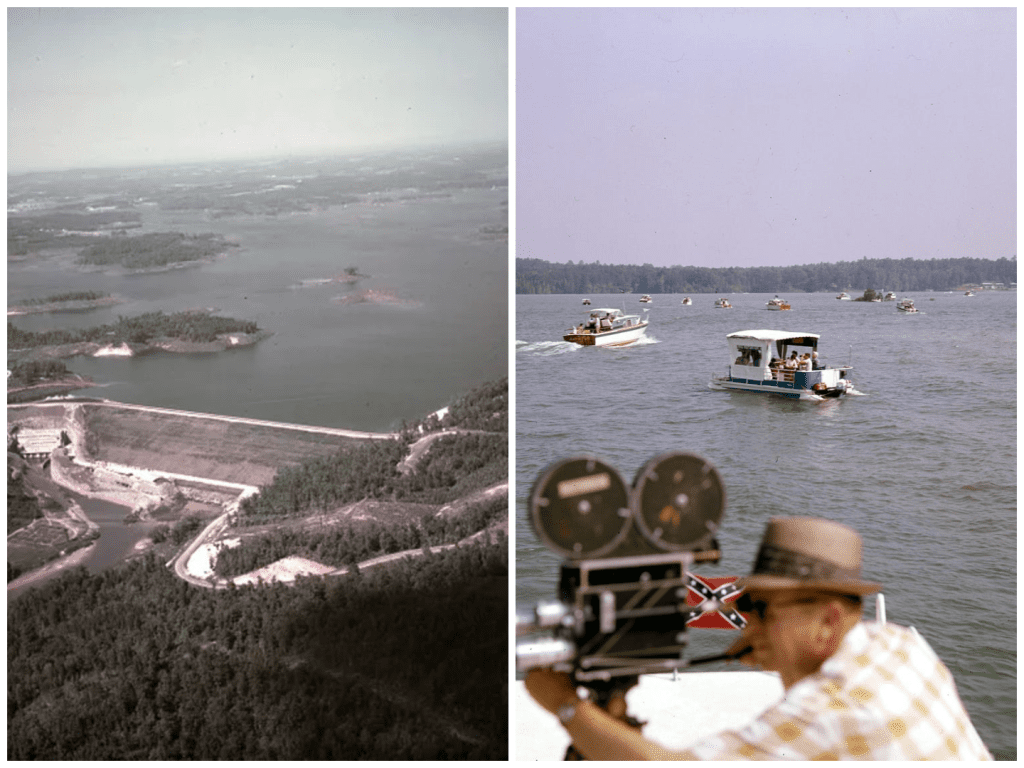There’s a Real Town Trapped Under This Lake in the U.S. — And When the Water Drops, Its Ghost Comes Back to Life

If you stand on the edge of Lake Lanier in Georgia on a quiet day, you might hear the wind rustling through the trees, waves lapping against the shore, or laughter from boats passing by. But what you won’t see—unless the water drops—is the ghost of a town that used to live right where you’re standing. Roads. Buildings. Graves. An entire history sealed beneath the surface.
It sounds like something out of a movie. But it’s real. Lake Lanier, one of Georgia’s most popular recreational lakes, hides something that still gives locals an eerie chill: a forgotten town underwater.
Before the lake was built, this part of north Georgia wasn’t water. It was land—full of homes, farms, churches, cemeteries, and life. The town of Oscarville, a once-thriving Black community in Forsyth County, was one of the many that vanished when the government decided to flood the area in the 1950s. The idea was to create a massive reservoir to supply water and electricity to Atlanta. It would help the city grow. It would offer jobs. It would bring boating, fishing, and fun.
And it did. But it also erased something.

To make Lake Lanier, the U.S. Army Corps of Engineers bought out landowners, moved some homes, and cleared trees. But they didn’t take everything. In their rush to flood the valley, many buildings were left behind—including churches, barns, and even graveyards. Concrete foundations, paved roads, and structures still sit at the lake’s bottom, mostly forgotten except when the water level drops low enough to expose them. It doesn’t happen often, but when it does, it’s haunting.
There’s no official map showing what’s still down there. That’s part of the mystery. Divers over the years have reported cemetery plots, old roads, and crumbling houses. Some say you can even see the outlines of buildings, like ghostly blueprints on the lakebed. And while there’s no solid proof that entire structures remain perfectly intact, one thing is clear: what was once a town didn’t just disappear—it’s still there, beneath the surface.
Over time, Lake Lanier has picked up an unsettling reputation. Some call it cursed. Others just say it’s unlucky. There have been hundreds of drownings and accidents on the lake since it opened—many more than most other lakes its size. Some believe the spirits of the past haven’t fully rested. Others blame its steep drop-offs, low visibility, and underwater debris for the dangers. Either way, locals speak of it with a mix of love and unease.
But Lake Lanier isn’t the only one.

Across the United States, there are several lakes with entire towns lying silently underneath. Folsom Lake in California, for example, made headlines in 2014 when drought dropped the water level so low that the ghost town of Mormon Island reappeared—complete with stone walls and iron tools still buried in the ground. In North Carolina, Fontana Lake covers the town of Judson, and every once in a while, the old Highway 288 shows itself again, winding through what’s now the bottom of a reservoir. And in Nevada, during extreme drought, St. Thomas rises up from Lake Mead like a sunken relic of a forgotten era.
These places all share something powerful in common. They’re not just ruins or debris—they’re memories. They were once places where people were born, grew up, fell in love, worked, worshipped, and were buried. Then, one day, those people were told to leave. Their homes would be underwater soon. And they left, carrying only what they could.
But the towns? The foundations? The cemeteries? Much of it was left behind.
For those who grew up hearing stories of Oscarville or Judson, these lakes are more than water—they’re wounds. Generational ones. In the case of Oscarville, the history is especially tragic. The town was violently emptied before the lake even came into the picture. In the early 1900s, white mobs drove Black families out of Forsyth County. Their land was stolen. Their homes were burned. And when the reservoir was planned decades later, no one made an effort to restore what was lost. It was simply drowned.
Now, the story of what’s beneath Lake Lanier is being rediscovered—not just by curious tourists or TikTok divers, but by descendants of those who once lived there. There’s a growing call for recognition. Not necessarily to drain the lake or dig up its past, but to remember what lies beneath the surface. Because it’s not just water. It’s history.
Visitors to these lakes today rarely know what’s under their kayaks or jet skis. Families gather for picnics, people fish from docks, and boaters fly across the surface without a clue that beneath them are church walls, street signs, or tombstones. That disconnect is part of what makes these places so strange, so haunting, and so important to talk about.
And maybe that’s the message these underwater towns offer us. That history can’t be erased just by covering it up. It lingers—in memory, in water, and sometimes, in the quiet, crumbling ruins that resurface when the levels get low enough.
So the next time you visit a lake like Lanier or Folsom or Fontana, take a moment. Look at the calm water. Think about what might be just a few feet below. Someone once called it home.

Lena Carter is a travel writer and photographer passionate about uncovering the beauty and diversity of the world’s most stunning destinations. With a background in cultural journalism and over five years of experience in travel blogging, she focuses on turning real-world visuals into inspiring stories. Lena believes that every city, village, and natural wonder has a unique story to tell — and she’s here to share it one photo and article at a time.





